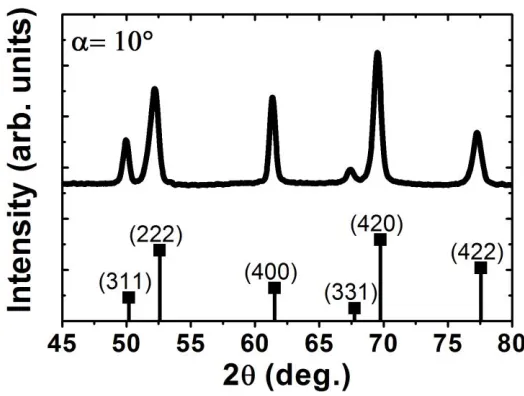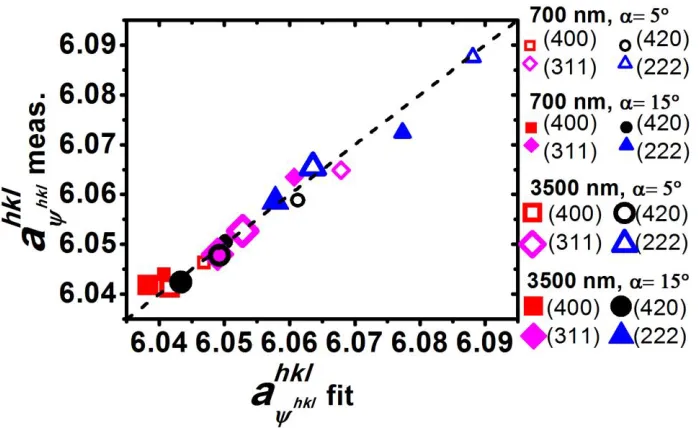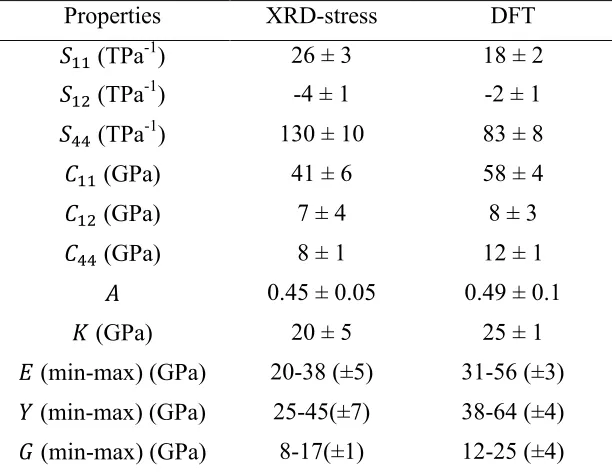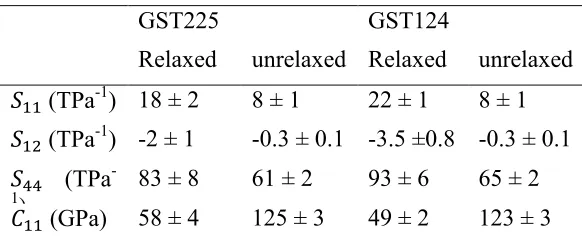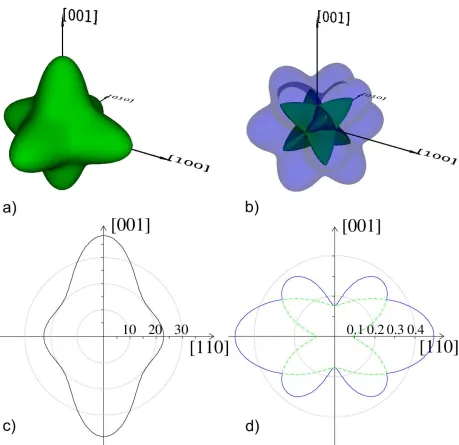Determination of the Anisotropic Elastic Properties
of Rocksalt Ge
2
Sb
2
Te
5
by XRD, Residual Stress and
DFT
Raimondo Cecchini†,1, Krisztian Kohary‡, Asunción Fernández†, Marcello Cabibbo§, Arnaud
Marmier‡,*
†Instituto de Ciencia de Materiales de Sevilla, CSIC-Universidad de Sevilla, Avenida Américo
Vespucio 49, 41092 -Seville, Spain.
‡College of Engineering, Mathematics and Physical Sciences, University of Exeter, Exeter EX4
4QF, United Kingdom.
§Department of Mechanical Engineering, Università Politecnica delle Marche, via Brecce
Bianche, 60131, Ancona, Italy.
KEYWORDS Chalcogenide films, phase change, optical storage, random access memory, elasticity
Abstract
The chalcogenide material Ge2Sb2Te5 is the prototype phase-change material, with widespread
applications for optical media and random access memory. However, the full set of its independent elastic properties has not yet been published. In this study, we determine the elastic constants of the rocksalt Ge2Sb2Te5, experimentally by x-ray diffraction (XRD) and residual
1. INTRODUCTION
Chalcogenide films have been employed in phase-change type optical storage media1-2 (CD-RW, DVD-(CD-RW, Blu-Ray DVD) and, more recently, in phase-change random access memory (PCRAM) 3-5. The Ge-Sb-Te (GST) system and in particular the Ge2Sb2Te5 alloy (GST225), are
Despite their relevance to real systems and devices, no measurements of the full set of face-centered cubic (FCC) GST225 elastic properties have been reported to date. Published results are generally limited to the bulk modulus (K)7, 19-21, with a few mentions of the biaxial (Y)and Young’s moduli (E)8, 11, 22. Recent simulations have indicated that the closely related material Ge1Sb2Te4 (GST124) exhibits significant elastic anisotropy with a Zener ratio (A) of 0.24 23. The
results for GST124 are more detailed than for GST225, with a full set of elastic constants from density functional theory (DFT) calculations 23 and a partial set (isotropic approximation) from Brillouin Light Scattering (BLS) 24. Recently, the elastic coefficients of stable trigonal GST225 have been calculated by DFT25. The picture resulting from these results is that the data are almost equally divided between two hypotheses: high compressibility with K around 20 GPa and low compressibility with K around 40 GPa.
The following section presents the methods used to measure and calculate the elastic properties. Our experimental approach, a combination of x-ray diffraction and residual stress measurements, has not been used previously to directly measure elastic tensors, and is introduced with much detail. We then present exhaustive results for elastic properties and show that the experimental and computational results are in very good agreement. Finally we demonstrate that elastic anisotropy must be taken into account.
2. EXPERIMENTAL AND COMPUTATIONAL METHODS
stochastic nature of the distribution of the Ge/Sb/vacancies sites makes simulating GST225 a delicate problem, requiring averaging over different configurations.
2.1. Experimental Details. GST225 films were deposited on single crystal Si(100)
substrates by direct-current magnetron sputtering from a target with composition Ge: Sb: Te = 2: 2: 5. Substrates temperature was kept at 130 ºC, deposition power was 0.5 kW and sputtering gas Ar pressure was 2 mTorr. Films were deposited with thicknesses of 700, 2000 and 3500 nm. We applied X-Ray diffraction (XRD) with fixed incidence angle and residual stress measurements by the curvature method on polycrystalline rocksalt GST225 films to measure the compliances terms (𝑆ij) from the Reuss’ model 26. XRD measurements are often used for the evaluation of the residual stress of thin films, and they are occasionally27 combined with the curvature method to check the validity of elastic constants. We are not aware of the use of combined XRD-stress measurement to determine elastic constants directly. The residual planar stress (𝜎∥) acting on the
films was evaluated by measuring the curvature radius of the samples before (𝑅) and after (𝑅′)
film deposition in different directions, to confirm the rotational symmetry of the state of stress, and by applying the Stoney’s equation 28-29: 𝜎∥= 𝑀𝑆𝑖(100)∙ 𝑡𝑆𝑖(100)2 𝑡
𝑓
⁄ ∙ 1 6(𝑅⁄ ′− 𝑅), where 𝑡 𝑓
is the thickness of the GST film and 𝑡𝑆𝑖(100)2 = 730 µm and 𝑀
𝑆𝑖(100) = 180.3 GPa are the
thickness and the biaxial modulus of the Si(100) substrate. The values of the curvature radius were obtained from the maximum samples deflections (h) measured by a Mahr ® Surf XR-20 stylus profilometer along traces of length L= 17.5 mm, by 𝑅 = 𝐿2⁄8ℎ. The resulting 𝜎
∥ values
angles of incidence (𝛼), with values of 1°, 5°, 10°, 15°, 20°, 30° and 45° and 2𝜃 scans from 45° to 80 ° with step size 0.025°. The XRD patterns recorded on 2000 nm thick film for 𝛼 = 10° are reported in Figure 1.
Figure 1. XRD patterns recorded for GST225 2000 nm film with fixed angle of incidence α = 10°. The positions and relative intensities of FCC GST225 peaks30 are also displayed.
As can be seen by comparison with previously reported XRD measurements 30, the films are polycrystalline with a FCC structure. Similarly to in Grazing Angle X-Ray Diffraction (GIXRD), in XRD with a fixed 𝛼 different inclination angles ( 𝜓 ) are obtained, according to: 𝜓ℎ𝑘𝑙 = 𝜃ℎ𝑘𝑙− 𝛼, where 𝜃
ℎ𝑘𝑙 is the diffraction angle for the (ℎ𝑘𝑙) plane. A fixed angle of incidence
allows for better control of the x-ray penetration depth. However, while in GIXRD low values of
𝛼 are generally used to increase the signal from very thin films, we used a relatively large 𝛼
range in order to obtain a large enough range of 𝜓ℎ𝑘𝑙 and allow for the measurement of the
the strained lattice constant (𝑎ψℎ𝑘𝑙ℎ𝑘𝑙) are given by the Bragg’s equation: 𝑎ψℎ𝑘𝑙ℎ𝑘𝑙 =2 sin 𝜃𝜆𝐶𝑢 𝐾𝛼ℎ𝑘𝑙√ℎ2𝑘2𝑙2.
For macroscopically elastically isotropic materials subjected to rotationally symmetric biaxial
stress, the relationship between strain, 𝑎𝜓ℎ𝑘𝑙
ℎ𝑘𝑙 −𝑎 0
𝑎0 (where 𝑎0 is the value of the unstrained lattice
parameter) and 𝜎∥is given by 31
𝑎
𝜓ℎ𝑘𝑙 ℎ𝑘𝑙 −𝑎
0
𝑎0 = (2𝑆1
ℎ𝑘𝑙 +1 2𝑆2
ℎ𝑘𝑙𝑠𝑖𝑛2𝜓ℎ𝑘𝑙) 𝜎
∥ (1)
with and 𝑆1ℎ𝑘𝑙 and 𝑆
2ℎ𝑘𝑙 the hkl-dependent diffraction elastic compliances. In terms of the
Reuss’ model, the independent terms of the compliance tensor 𝑆11, 𝑆12 and 𝑆44 are related to the hkl-dependent diffraction compliances (𝑆1ℎ𝑘𝑙,1
2𝑆2
ℎ𝑘𝑙) by the equations31 𝑆1ℎ𝑘𝑙 = 𝑆
12+ 𝑆0Γ(ℎ𝑘𝑙) (2)
and
1 2𝑆2
ℎ𝑘𝑙 = 𝑆
11− 𝑆12− 3𝑆0Γ(ℎ𝑘𝑙) (3),
where 𝑆0 = 𝑆11− 𝑆12− 𝑆44⁄2 and Γ(ℎ𝑘𝑙) = (ℎ2𝑘2+ 𝑘2𝑙2+𝑙2ℎ2) (ℎ⁄ 2+ 𝑘2+𝑙2)2 is the
orientation factor for cubic materials. Replacing eq. (2) and (3) into eq. (1) leads to
𝑎𝜓ℎ𝑘𝑙ℎ𝑘𝑙 = 𝑎0{[2(𝑆12+ 𝑆0Γ(ℎ𝑘𝑙)) + (𝑆11− 𝑆12− 3𝑆0Γ(ℎ𝑘𝑙))𝑠𝑖𝑛2𝜓ℎ𝑘𝑙]𝜎∥+ 1}. (4)
The values of 𝑎0, 𝑆11, 𝑆12 and 𝑆0 for GST225 were obtained by a weighted least-square fitting by eq. (4) of the measured 𝑎𝜓ℎ𝑘𝑙ℎ𝑘𝑙 and 𝑠𝑖𝑛2𝜓ℎ𝑘𝑙 values for the different films and different
a
.The goodness of the fit can be estimated by comparing the measured 𝑎𝜓ℎ𝑘𝑙ℎ𝑘𝑙 with those calculated
from eq. (4) with 𝑎0, 𝑆11, 𝑆12 and 𝑆0 obtained from the fit (Figure 2). In order to make the plot
curvature method and by the possible presence of a gradient of the stress along the film thickness. It is generally observed that the uncertainty for this type of measurement is of the order of 10%. However, evaluation of the curvature of the samples after the film deposition can introduce relatively large errors, especially for the smallest thickness, where the change of curvature is relatively small. Moreover, the value measured by the curvature method represents the average residual stress of the films, while the stress might change throughout the film thickness. The diffracted signal might therefore come from a depth where the value of the stress differs from its average value. We used different values of incident angle in order to collect information from a wide range of films depths and average out the effect of stress gradients.
Figure 2. (color online) Plot of XRD measured strained lattice constant values (𝑎𝜓ℎ𝑘𝑙ℎ𝑘𝑙 𝑚𝑒𝑎𝑠. ) vs.
those calculated from eq. (4) with 𝑎0, 𝑆11, 𝑆12 and 𝑆0 obtained from the fit (𝑎𝜓ℎ𝑘𝑙ℎ𝑘𝑙 𝑓𝑖𝑡). The
2.2. Computational Details. We performed DFT simulations in the framework of the
generalized gradient approximation (GGA) with Perdew-Burke-Ernzerhof (PBE) functional and projector augmented wave-method (PAW) potentials using the VASP software32-35. The calculations were performed with energy cutoff of 15 Ha and Monkhorst-Pack grids of 4×4×4 k-points. GST225 crystallizes in the FCC rocksalt system with two sublattices occupied by either Te atoms (“A” sublattice) or Ge/Sb atoms and vacancies (“B” sublattice). In order to conserve the somewhat awkward stoichiometry, we generated eight 36-atoms GST225 structures using a 2×2×5 replication of the “primitive” FCC unit cell (with one site for each of the two sublattices). The spatial distribution of Ge, Sb and vacancies in the “B” sublattice was determined by a random number generator. Eight such configurations were relaxed, and the full compliance tensors were calculated. Due to the random distribution in one sublattice, the relaxed supercells, and the associated elastic tensors, although quasi-cubic, do belong to the triclinic crystal system. The three cubic stiffnesses (C) are obtained by a direct averaging of the relevant triclinic
stiffnesses (𝐶11𝑐𝑢𝑏 = (∑ 𝐶 𝑖𝑖𝑡𝑟𝑖
𝑖=1,3 ) 3⁄ , 𝐶12𝑐𝑢𝑏 = (∑ 𝑖=1,3 𝐶𝑖𝑗𝑡𝑟𝑖
𝑗=1,3,𝑗≠𝑖 ) 6⁄ , 𝐶44
𝑐𝑢𝑏 = (∑ 𝐶
𝑖𝑖𝑡𝑟𝑖
𝑖=4,6 ) 3⁄ ). The
errors quoted for these results are simply standard deviation errors from these averaging; they underestimate the actual errors inherent to DFT and are not directly comparable with the experimental errors.
2.3. Elasticity considerations. Due to the cubic symmetry imparted on the elastic tensors,
ratio (ν) and shear modulus (G) are very heavy. We use the dedicated software ElAM36 to carry out the tensor transformations and compute various representative values (minima, maxima, averages), as well as graphically represent the different values of an elastic property.
3. RESULTS AND DISCUSSION
[image:10.612.154.460.474.712.2]The first and simplest quantity we address is the lattice parameter 𝑎0 which is 6.035±0.001 Å from XRD-stress and 6.12 ±0.05 Å from DFT (agreement within 2%). In fact, it is not surprising that the DFT value is larger than the experimental one as the GGA functionals tend to overestimate lattice parameters, at 6.05 Å from37 and 6.04 Å from38 (conversely, the LDA functionals tends to underestimate lattice parameters, at 5.90 Å from39 ). The results are also very close to experimental values for GST225 films30, where 𝑎0 varies between 6.025 Å and 6.050 Å.
Table 1. Elastic properties (compliances, stiffnesses, Zener ratio, bulk modulus, Young’s modulus, biaxial modulus, shear modulus and Poisson’s ratio) of GST225 obtained from
XRD-stress and PAW-DFT.
Properties XRD-stress DFT
𝑆11 (TPa-1) 26 ± 3 18 ± 2
𝑆12 (TPa-1) -4 ± 1 -2 ± 1
𝑆44 (TPa-1) 130 ± 10 83 ± 8
𝐶11 (GPa) 41 ± 6 58 ± 4
𝐶12 (GPa) 7 ± 4 8 ± 3
𝐶44 (GPa) 8 ± 1 12 ± 1
𝐴 0.45 ± 0.05 0.49 ± 0.1
𝐾 (GPa) 20 ± 5 25 ± 1
𝐸(min-max) (GPa) 20-38 (±5) 31-56 (±3)
𝑌(min-max) (GPa) 25-45(±7) 38-64 (±4)
𝜈(min-max) (GPa) 0.09-0.49(± 0.2) 0.07-0.45 (±0.02)
Figure 3. (color online) Interatomic bonds in the <100> directions for a) GST124, b) GST225. Two contiguous 20 atoms sections of <100> planes are represented, the furthest with full symbols, the closest with hollow symbols. Triangles depict Ge atoms, circles Sb atoms and squares Te atoms. Blurred squares, full or hollow, represent unbonded Te atoms and are indicative of a vacancy in the other plane.
[image:12.612.65.356.589.707.2]The explanation for the much stiffer GST124 results is that in this previous study23 we reported the full set of elastic constants for a 7 atoms GST124 cell, and, due to symmetry, the positions of the atoms could not be relaxed prior to differentiating the energy to access the stiffnesses. Table 2 displays the elastic constants for relaxed and unrelaxed GST124 and GST225 with 64 and 36 atoms unit cells respectively, and demonstrates why it is important to use large enough unit cells so that ionic relaxation is not prohibited by symmetry in order to obtain accurate elastic coefficients. In both relaxed and unrelaxed cases, GST225 with more bonds is stiffer in the [100] direction than GST124 by factors of 17.85/15 (relaxed) and 15.28/15 (unrelaxed) (𝐸[100] = 1 𝑆⁄ 11), which indicates that the bound counting hypothesis is at best a rough approximation.
Table 2. Elastic properties (compliances, stiffnesses and bulk modulus) of GST225 and GST124 from PAW-DFT with and without ionic relaxation (compliances in TPa-1, Stiffnesses and bulk modulus in GPa).
GST225 GST124
Relaxed unrelaxed Relaxed unrelaxed
𝑆11 (TPa-1) 18 ± 2 8 ± 1 22 ± 1 8 ± 1
𝑆12 (TPa-1) -2 ± 1 -0.3 ± 0.1 -3.5 ±0.8 -0.3 ± 0.1
𝑆44 (TPa
-1) 83 ± 8 61 ± 2 93 ± 6 65 ± 2
𝐶12 (GPa) 8 ± 3 4 ± 1 9 ± 1 4 ± 1 𝐶44 (GPa) 12 ± 1 16 ± 1 11 ± 1 15 ± 1
𝐾 (GPa) 25 ± 1 45 ± 1 23 ± 1 44 ± 1
The only elastic property for which multiple results are available is the bulk modulus K. Published values range from 27 GPa to 58 GPa, a discrepancy of 114%. This discrepancy cannot be attributed solely to methodological differences, as experimentally determined K are 27 GPa (BLS)24 and 39-41 GPa (XRD)7, 19, while simulation results vary between 27 GPa and 58 GPa. From the elastic constants determined by XRD-stress, we obtain a value of K at around 20 GPa, with an estimated error of 5 GPa. This result suggests a bulk modulus at the lower end of the scale. This value is also in good agreement with our DFT-PAW results, which predict a value of 25 GPa (±1 GPa). Table 2 also illustrates the effect of atomic relaxation on the bulk modulus: it is significant, as relaxed systems are 80% more compressible than unrelaxed ones. Careful re-examination of previous simulation results confirms that this effect accounts for the larger values of K. With this in mind, we believe that the actual value for K lies between 20 and 30 GPa, as the only remaining outliers are the XRD results from 7 and 19.
For a cubic material, the elastic anisotropy is often described by the Zener ratio 𝐴 = 2𝐶44⁄(𝐶11− 𝐶12); this corresponds to the ratio of the shear moduli in the [100] and [110]
directions, and elastic isotropy corresponds to 𝐴 = 1. Our experimental and simulation values for
𝐴 are in excellent agreement, with values at 0.46 and 0.48 respectively, both slightly lower than 0.5. This suggests that the shear modulus in the [100] direction is lower than the shear modulus in the [110] direction, which is relatively uncommon, especially for crystals with a FCC lattice27. For these materials, it is more meaningful to use the Ledbetter anisotropy index 𝐴∗ to estimate
gives experimental and theoretical values of 2.17 and 2.11 respectively. From published databases of elastic constants41, the median Ledbetter index for cubic crystals is 2.08. This suggests that the elastic anisotropy of cubic GST225 is indicative of that of cubic crystals in general, and that GST225 cannot realistically be modelled as an isotropic material. Due to its simplicity, the Zener ratio 𝐴 is the most often used generic descriptor of elastic anisotropy for cubic crystal systems, but it is certainly not the only possible one. In addition, provided that elastic tensors are available, it is possible to determine the anisotropy of a specific property. The anisotropy of E, defined as the ratio of its maximum by its minimum, is 1.90 for XRD-stress and 1.83 for PAW-DFT. Figures 4(a) and 4(c) display the angular dependence of Young’s modulus E
Considering the good agreement between stiffness coefficients, it is not surprising that the Young’s modulus values also agree well. The XRD-stress value varies between 20 GPa and 39 GPa while the PAW-DFT value varies between 31 GPa and 57 GPa. The only comparable value is 39 GPa, derived from BLS experiments. Such is the importance of the modulus of elasticity, it is very surprising that it has not been measured more often. The biaxial modulus Y has been measured and analysed by micromechanical methods such as curvature measurement8, 11, 22 and nanoindentation22, 42, and measured values vary between 37 and 59 GPa. In an anisotropic material, Y depends on the plane in which the stress is applied, and we obtain values that vary between 25 and 45 GPa with XRD-stress and between 38 and 64 GPa with PAW-DFT.
We are not aware of any measurement or calculations of the shear modulus and of the Poisson’s ratio. The measured and calculated values are in good agreement, especially concerning Poisson’s ratio for GST225. Both shear modulus and Poisson’s ratio are anisotropic, but do not otherwise display any exotic behavior. Figure 4(b) displays in a spherical plot the maximum and minimum values of Poisson’s ratio and 4(d) is a cross section of the same in the
(1̅10) plane. Both figures illustrate the anisotropy of the Poisson’s ratio; the maximum and minimum values are both located along the <110> directions, at 0.49 and 0.09 respectively.
The agreement between the results of simulation and measurements is especially good for the relative value of elastic properties. While the experimental uncertainties associated with the residual stress have a direct impact on the absolute values of elastic constants (𝜎∥ being a
common multiplying factor for 𝑆11, 𝑆12 and 𝑆0 in Eq. 4), the effect of its error is partly cancelled
out in the calculation of the relative elastic properties.
In summary, we have evaluated the elastic properties of FCC phase of GST225 by experimental (XRD and residual stress) and theoretical methods (PAW-DFT). Both set of results are in good agreement and suggest that GST225 is rather compliant, with a bulk modulus around 20 GPa, at the lower end of what had previously been measured or calculated. Both methods also predict significant elastic anisotropy with Zener ratio around 0.5.
AUTHOR INFORMATION
Corresponding Author
*E-mail address: a.s.h.marmier@exeter.ac.uk
Present Addresses
ACKNOWLEDGMENT
We gratefully acknowledge funding from European FP6 framework program-EXCELL Project NoE 5157032, CSIC (NANO-CONTROL 201060E102), Spanish Ministry MICINN (Consolider FUNCOAT CSD2008-00023) and Junta de Andalucia (TEP217). The authors are grateful to Dr. M. Tonelli of the CIGS of the UniMoRe, Modena, Italy for performing the XRD measurements.
REFERENCES
1. Feinleib, J.; de Neufville, J.; Moss, S. C.; Ovshinsky, S. R. Rapid Reversible Light-Induced Crystallization of Amorphous Semiconductors. Appl. Phys. Lett. 1971, 18, 254-257. 2. Raoux, S.; Welnic, W.; Ielmini, D. Phase Change Materials and Their Application to Nonvolatile Memories. Chem. Rev. 2010, 110, 240-267.
3. Pirovano, A.; Pellizzer, F.; Tortorelli, I.; Riganó, A.; Harrigan, R.; Magistretti, M.; Petruzza, P.; Varesi, E.; Redaelli, A.; Erbetta, D. Phase-Change Memory Technology with Self-Aligned Μtrench Cell Architecture for 90nm Node and Beyond. Solid·State Electron. 2008, 52, 1467-1472.
4. Wuttig, M.; Yamada, N. Phase-Change Materials for Rewriteable Data Storage. Nature Materials 2007, 6, 824-832.
5. Wong, H. S. P.; Raoux, S.; Kim, S.; Liang, J.; Reifenberg, J. P.; Rajendran, B.; Asheghi, M.; Goodson, K. E. Phase Change Memory. Proc. IEEE 2010, 98, 2201-2227.
6. Kolobov, A. V.; Haines, J.; Pradel, A.; Ribes, M.; Fons, P.; Tominaga, J.; Steimer, C.; Aquilanti, G.; Pascarelli, S. Pressure-Induced Amorphization of Quasibinary Gete-Sb2Te3: The
Role of Vacancies. Appl. Phys. Lett. 2007, 91, 021911.
7. Krbal, M.; Kolobov, A. V.; Haines, J.; Pradel, A.; Ribes, M.; Fons, P.; Tominaga, J.; Levelut, C.; Le Parc, R.; Hanfland, M. Temperature Independence of Pressure-Induced Amorphization of the Phase-Change Memory Alloy Ge2Sb2Te5. Appl. Phys. Lett. 2008, 93,
031918.
9. Xu, M.; Cheng, Y.; Wang, L.; Sheng, H.; Meng, Y.; Yang, W.; Han, X.; Ma, E. Pressure Tunes Electrical Resistivity by Four Orders of Magnitude in Amorphous Ge2Sb2Te5
Phase-Change Memory Alloy. Proceedings of the National Academy of Sciences 2012, 109, E1055-E1062.
10. Xu, B.; Su, Y.; Liu, Z. G.; Zhang, C. H.; Xia, Y. D.; Yin, J.; Xu, Z.; Ren, W. C.; Xiang, Y. H. Effects of Hydrostatic Pressure on the Electrical Properties of Hexagonal Ge2sb2te5:
Experimental and Theoretical Approaches. Appl. Phys. Lett. 2011, 98, 142112.
11. Pedersen, T. P. L.; Kalb, J.; Njoroge, W. K.; Wamwangi, D.; Wuttig, M.; Spaepen, F. Mechanical Stresses Upon Crystallization in Phase Change Materials. Appl. Phys. Lett. 2001, 79, 3597-3599.
12. Nam, S.-W.; Chung, H.-S.; Lo, Y. C.; Qi, L.; Li, J.; Lu, Y.; Johnson, A. C.; Jung, Y.; Nukala, P.; Agarwal, R. Electrical Wind Force–Driven and Dislocation-Templated Amorphization in Phase-Change Nanowires. Science 2012, 336, 1561-1566.
13. Kolobov, A.; Krbal, M.; Fons, P.; Tominaga, J.; Uruga, T. Distortion-Triggered Loss of Long-Range Order in Solids with Bonding Energy Hierarchy. Nature chemistry 2011, 3, 311-316.
14. Lee, J.; Park, H.; Cho, S.; Park, Y.; Bae, B.; Park, J.; Park, J.; An, H.; Bae, J.; Ahn, D. In
Highly Scalable Phase Change Memory with Cvd GeSbTe for Sub 50nm Generation, VLSI Technology, 2007 IEEE Symposium on, IEEE: 2007; pp 102-103.
15. Im, D.; Lee, J.; Cho, S.; An, H.; Kim, D.; Kim, I.; Park, H.; Ahn, D.; Horii, H.; Park, S. In A Unified 7.5 Nm Dash-Type Confined Cell for High Performance PRAM Device, Electron Devices Meeting, 2008. IEDM 2008. IEEE International, IEEE: 2008; pp 1-4.
16. Yu, B.; Sun, X.; Ju, S.; Janes, D. B.; Meyyappan, M. Chalcogenide-Nanowire-Based Phase Change Memory. Nanotechnology, IEEE Transactions on 2008, 7, 496-502.
17. Longo, M.; Fallica, R.; Wiemer, C.; Salicio, O.; Fanciulli, M.; Rotunno, E.; Lazzarini, L. Metal Organic Chemical Vapor Deposition of Phase Change Ge1Sb2Te4 Nanowires. Nano Lett.
2012, 12, 1509-1515.
18. Giusca, C. E.; Stolojan, V.; Sloan, J.; Börrnert, F.; Shiozawa, H.; Sader, K.; Rümmeli, M. H.; Büchner, B.; Silva, S. R. P. Confined Crystals of the Smallest Phase-Change Material. Nano Lett. 2013, 13, 4020-4027.
19. Kolobov, A. V.; Haines, J.; Pradel, A.; Ribes, M.; Fons, P.; Tominaga, J.; Katayama, Y.; Hammouda, T.; Uruga, T. Pressure-Induced Site-Selective Disordering of Ge2Sb2Te5: A New
Insight into Phase-Change Optical Recording. Phys. Rev. Lett. 2006, 97, 035701.
20. Caravati, S.; Bernasconi, M.; Kuhne, T. D.; Krack, M.; Parrinello, M. Unravelling the Mechanism of Pressure Induced Amorphization of Phase Change Materials. Phys. Rev. Lett.
2009, 102, 205502.
21. Zhou, J.; Sun, Z. M.; Xu, L. H.; Ahuja, R. Effect of Dopants on the Structure and Properties of Ge2Sb2Te5 Studied by Ab Initio Calculations. Solid State Commun. 2008, 148,
113-116.
22. Park, I. M.; Jung, J. K.; Ryu, S. O.; Choi, K. J.; Yu, B. G.; Park, Y. B.; Han, S. M.; Joo, Y. C. Thermomechanical Properties and Mechanical Stresses of Ge2Sb2Te5 Films in
Phase-Change Random Access Memory. Thin Solid Films 2008, 517, 848-852.
24. Blachowicz, T.; Beghi, M. G.; Guntherodt, G.; Beschoten, B.; Dieker, H.; Wuttig, M. Crystalline Phases in the GeSb2Te4 Alloy System: Phase Transitions and Elastic Properties. J. Appl. Phys. 2007, 102, 093519.
25. Sa, B.; Zhou, J.; Ahuja, R.; Sun, Z. First-Principles Investigations of Electronic and Mechanical Properties for Stable Ge2Sb2Te5 with Van der Waals Corrections. Computational materials science 2014, 82, 66-69.
26. Reuss, A. Berechnung Der Fließgrenze Von Mischkristallen Auf Grund Der Plastizitätsbedingung Für Einkristalle. Zeitschrift für Angewandte Mathematik und Mechanik
1929, 9, 49-58.
27. Gressmann, T.; Wohlschlögel, M.; Shang, S.; Welzel, U.; Leineweber, A.; Mittemeijer, E.; Liu, Z.-K. Elastic Anisotropy of Γ′-Fe4N and Elastic Grain Interaction in Γ′-Fe4N1−Y Layers
on Α-Fe: First-Principles Calculations and Diffraction Stress Measurements. Acta Mater. 2007,
55, 5833-5843.
28. Stoney, G. G. The Tension of Metallic Films Deposited by Electrolysis. Proceedings of the Royal Society of London. Series A, Containing Papers of a Mathematical and Physical Character 1909, 82, 172-175.
29. Janssen, G. Stress and Strain in Polycrystalline Thin Films. Thin Solid Films 2007, 515, 6654-6664.
30. Yamada, N.; Matsunaga, T. Structure of Laser-Crystallized Ge2Sb2+XTe5 Sputtered Thin
Films for Use in Optical Memory. J. Appl. Phys. 2000, 88, 7020-7028.
31. Welzel, U.; Ligot, J.; Lamparter, P.; Vermeulen, A.; Mittemeijer, E. Stress Analysis of Polycrystalline Thin Films and Surface Regions by X-Ray Diffraction. J. Appl. Crystallogr.
2005, 38, 1-29.
32. Kresse, G.; Furthmuller, J. Efficiency of Ab-Initio Total Energy Calculations for Metals and Semiconductors Using a Plane-Wave Basis Set. Computational Materials Science 1996, 6, 15-50.
33. Kresse, G.; Furthmuller, J. Efficient Iterative Schemes for Ab Initio Total-Energy Calculations Using a Plane-Wave Basis Set. Physical Review B 1996, 54, 11169-11186.
34. Kresse, G.; Hafner, J. Abinitio Molecular-Dynamics for Liquid-Metals. Physical Review B 1993, 47, 558-561.
35. Kresse, G.; Hafner, J. Ab-Initio Molecular-Dynamics Simulation of the Liquid-Metal Amorphous-Semiconductor Transition in Germanium. Physical Review B 1994, 49, 14251-14269.
36. Marmier, A.; Lethbridge, Z. A. D.; Walton, R. I.; Smith, C. W.; Parker, S. C.; Evans, K. E. ElAM: A Computer Program for the Analysis and Representation of Anisotropic Elastic Properties. Comput. Phys. Commun. 2010, 181, 2102-2115.
37. Sun, Z.; Zhou, J.; Ahuja, R. Structure of Phase Change Materials for Data Storage. Phys. Rev. Lett. 2006, 96, 055507.
38. Lee, G.; Jhi, S.-H. Ab Initio Studies of Structural and Electronic Properties of the Crystalline Ge2sb2te5. Physical Review B 2008, 77, 153201.
39. Tsafack, T.; Piccinini, E.; Lee, B.-S.; Pop, E.; Rudan, M. Electronic, Optical and Thermal Properties of the Hexagonal and Rocksalt-Like Ge2Sb2Te5 Chalcogenide from First-Principle
Calculations. J. Appl. Phys. 2011, 110, 063716.
41. Every, A. G.; McCurdy, A. K., Low Frequency Propertie of Dielectric Crystals. In
Landolt-Börnstein, Numerical Data and Functional Relationships in Science and Technology, Springer Verlag: Berlin, 1993; Vol. 29a.
